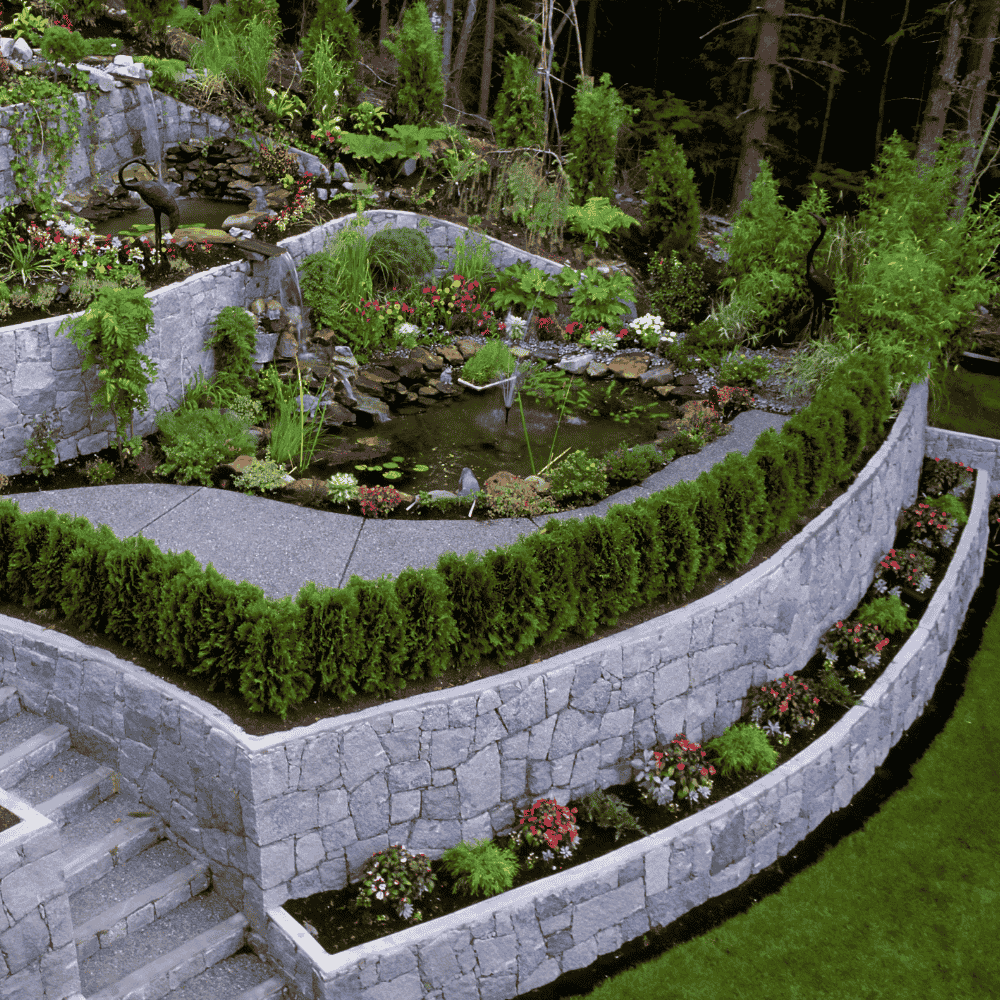How Retaining Walls Contribute to Landscape Stability and Style
A professional hardscaping approach guarantees that retaining walls provide long-term stability while complementing the landscape.
One of the primary goals of a retaining wall is to stabilize soil on sloped terrain. In landscapes with elevation changes, gravity constantly works against soil integrity, causing it to erode and shift over time. This erosion degrades the landscape and can threaten nearby foundations, patios, and pathways. A retaining wall acts as a protective boundary, holding back soil and minimizing runoff during heavy rains. These structures preserve the surrounding landscape and protect residential and commercial properties from costly damage by preventing erosion.
Maximizing Usable Outdoor Space
Beyond structural stability, retaining walls are excellent solutions for improving the functionality of uneven terrain. Sloped yards often go underutilized because they are difficult to mow, landscape, or build upon. Retaining walls make it possible to convert slopes into flat, level terraces supporting gardens, seating areas, walkways, and recreational zones. These usable surfaces increase outdoor living space and allow for creative landscaping opportunities that wouldn't otherwise be feasible.
Choosing the Right Materials for Strength and Style
Material choice plays a major role in a retaining wall's durability and appearance. Choices such as natural stone, concrete blocks, and brick provide the strength needed to support the landscape while offering a variety of colors, textures, and finishes. The material selection should reflect the homeowner's design preferences while matching the landscape's practical needs.
Incorporating Essential Drainage Features
In addition to materials, a properly engineered retaining wall must incorporate drainage solutions to maintain long-term integrity. When water collects behind a wall without a way to escape, it creates hydrostatic pressure that can lead to bulging, cracking, or even collapse. Professional installers integrate drainage systems such as gravel backfill, perforated pipes, and weep holes into the construction to avoid this.
Creating Visual Interest with Multi-Tiered Designs
Multi-tiered retaining walls offer function and flair for homeowners looking to include visual interest in their outdoor space. These tiered structures create dimension by introducing height variations across the landscape. Each level can have a different purpose, from planting beds and garden terraces to decorative stone features or seating areas.
Customizing for Style, Function, and Flow
Another advantage of retaining walls is customization. Rather than simply acting as utilitarian borders, these features can be tailored to fit specific design goals. Curved retaining walls create a sense of movement and soften the rigidity of rectangular yards. Built-in seating or planters make walls more interactive and functional. Integrated steps provide safe access to different elevations within the yard, seamlessly combining form and function.
Relying on Professional Installation for Lasting Results
The success of any retaining wall lies in thoughtful design and expert construction. Professional hardscaping teams consider multiple factors, including soil composition, slope gradient, water flow, and intended use. Mistakes in retaining wall construction—such as poor drainage, improper material selection, or inadequate reinforcement—can lead to failure and costly repairs.
Merging Functionality and Aesthetics
Retaining walls serve as both problem solvers and design features. They reinforce slopes, redirect water, and transform challenging topography into functional outdoor environments. At the same time, they enhance curb appeal and add definition to yards and gardens. Whether used to frame a patio, create garden tiers, or define outdoor rooms, these structures provide value in more ways than one.
How Retaining Walls Contribute to Landscape Stability and Style
Retaining walls offer both structural benefits and aesthetic appeal, making them a key element in professional hardscaping. These carefully designed barriers prevent erosion, create usable space, and enhance the overall look of outdoor environments.
Soil stabilization serves as one of the most critical functions of retaining walls. Sloped landscapes often struggle with erosion, leading to instability and drainage issues. A well-constructed retaining wall holds back soil, reducing runoff and protecting the integrity of surrounding structures.
Functional outdoor spaces benefit greatly from retaining wall installation. Uneven terrain often limits landscape usability, but strategically placed walls create level areas for patios, gardens, and walkways. These additions maximize space, turning challenging landscapes into functional, inviting outdoor settings.
Material selection is significant in both durability and design. Natural stone, concrete blocks, and brick provide strength while offering an assortment of textures and finishes to complement any landscape. A professional hardscaping approach integrates materials that blend seamlessly with the environment, enhancing visual appeal and structural integrity.
Drainage solutions prevent water buildup and structural damage. Properly designed retaining walls incorporate drainage pipes, gravel backfill, and weep holes to direct water away from the structure. Without these features, hydrostatic pressure can compromise the wall's stability and surrounding areas.
Multi-tiered retaining walls add dimension and depth to a landscape. These designs create visually dynamic outdoor spaces by incorporating varying heights and layers. Plants, lighting, and decorative elements further enhance the aesthetic appeal, transforming retaining walls into striking focal points.
Customization options allow for integration into any landscape design. Curved walls soften rigid structures, while built-in seating, planters, and steps increase functionality. Thoughtful design choices elevate retaining walls from simple barriers to multi-purpose features that enhance outdoor living areas.
A Smart Investment in Outdoor Stability and Beauty
A professional hardscaping approach verifies that retaining walls provide long-term stability while complementing the landscape. Expert craftsmanship, strategic placement, and high-quality materials create durable and visually appealing outdoor spaces.
Ultimately, retaining walls are a smart investment for property owners who want to improve the stability and style of their landscapes. With the right materials, careful planning, and professional craftsmanship, retaining walls support healthy land development and enrich outdoor aesthetics. From soil control to sculptural beauty, they combine practicality and artistry in a way few other landscape features can.

